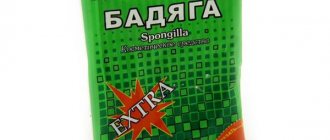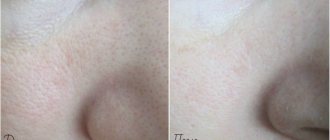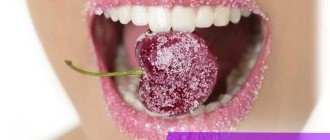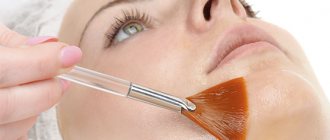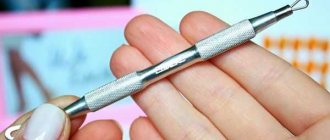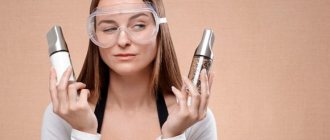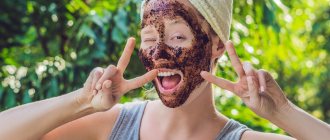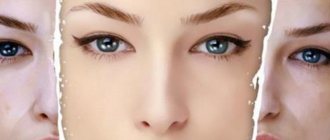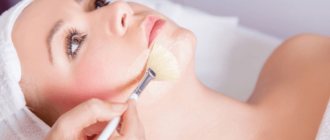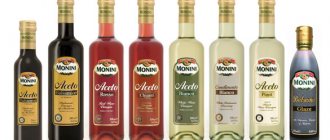Facial beauty begins with healthy, smooth and clean skin. But maintaining it in perfect condition is not an easy task, because every day a lot of troubles fall on our faces. If you didn’t wash off your makeup well before going to bed, you live in a city where particles of dirt and dust are constantly floating in the air, or your subcutaneous sebaceous glands are disrupted - all this leads to the pores being clogged and unable to breathe.
Blackheads and oily sheen appear, the face becomes blotchy, peels, the skin becomes covered with fine wrinkles, ages and sags. Not the most pleasant picture, you will agree. What can you do to make the reflection in the mirror happy again? If such problems arise, I advise you to use a wonderful and useful procedure - yellow retinol peeling. For a person with problem skin, this product is a real find and the key to beauty.
Effect on skin
Retinoic (yellow) peeling has an exfoliating mechanism of action that stimulates restoration and tissue renewal. Carotenoids (synthesized retinoic acid) cause mild skin burns. This allows you to remove the upper stratum corneum. Covers freed from unnecessary “ballast” look fresh and youthful. This is the principle of the mechanical action of peeling.
Retinoids, entering the tissue, stimulate the restoration of the epithelium. The production of collagen and elastin is accelerated, improving skin quality. Active growth of fresh cells is observed, which promotes rapid regeneration, restoration and rejuvenation of dermal structures. Local metabolic activity is noticeably activated, and the launch of protective mechanisms is provoked. Sebum secretion is normalized and the aging process is slowed down.
Ingredients for retinol peeling can be purchased at retail outlets specializing in professional cosmetics and pharmacies. Completely ready-to-use formulations and individual components are sold. The main required ingredient is retinoic acid (5–20% concentration). You can also use retinoic ointment. The component will cost 300–350 rubles. The procedure may also require: glycolic cream, salicylic acid. The ingredients can be purchased at any pharmacy.
Expert advice
Cosmetologists recommend retinoic cleansing of the epidermis as a stimulation of subcutaneous production of hyaluron, which is necessary to maintain the skin’s water balance. They also note its high effectiveness in eliminating age spots and report the ability of retinoic acid to reduce the number of atypical cells, which is the prevention of skin cancer.
We recommend: Acid facial peeling with aspirin. Recipes and features of the procedure at home
Also, for the first procedure, cosmetologists advise using a lower concentration of acid and not leaving the composition on the face for the maximum period.
Video with advice from a cosmetology specialist on the benefits of “yellow peeling”:
Yellow peeling is a non-invasive procedure, so it can be done at home. However, to avoid negative consequences, you should properly prepare all the components for the procedure and not exceed the dosage of retinoic acid , otherwise you can seriously injure the skin beyond the possibility of recovery. Then the yellow peeling will have its cleansing and restorative effect, rejuvenating the skin.
The essence of the procedure
Retinoic peeling refers to chemical options for exfoliating the upper layer of skin. The procedure is performed by a cosmetologist or independently. The essence of the intervention is to soften and exfoliate the keratinized epidermis.
This allows you to cleanse and rejuvenate the skin. The anti-aging effect is achieved only after completing a course of procedures. After retinoic peeling, the skin is actively renewed.
Fresh fabrics have “young” characteristics: density, firmness, elasticity. Thanks to the exfoliating effect of the procedure, the depth of existing wrinkles decreases, and the formation of new ones occurs at a lower rate.
Preparation for the procedure
Preparation for retinoic peeling sets it apart from other types of cosmetic services. Take at least a period that ranges from 2 weeks to a month. This period is due to the need to bring the skin to a normal state naturally: get rid of tan, regulate some processes. To do this, before doing retinoic peeling, you need to:
- do not visit the solarium, saunas, steam baths, too hot showers or baths;
- refuse cosmetics with any powerful acids, because retinoic acid is already aggressive;
- glycolic acid will soften the epidermis, which will facilitate the penetration of active components into the lower layers of the epidermis;
- refuse exfoliating agents, otherwise the full impact of the yellow peeling will be on the fresh skin;
- stay in the sun as little as possible.
Compliance with these rules is important, because retinoic care has a more aggressive and deeper effect than conventional cosmetics. Caution is required when working with medications.
Indications for use
Retinoic peeling is carried out to improve the quality of skin that has been exposed to age (flabby, mature skin), prone to various imbalances (oily, dry type of epidermis, impaired functioning of the sebaceous glands, improperly organized care system).
The procedure helps cleanse the tissues; completing a course of retinoic effects leads to an anti-aging effect.
Cosmetologists say that retinoic peeling is useful in the following cases:
- the presence of comedones (blackheads with white, pink contents);
- acne beyond the purulent stage of development;
- increased (decreased) sebum secretion;
- the occurrence of hyperpigmentation;
- the effects of aging (impaired firmness, elasticity, tissue density);
- the appearance of wrinkles;
- post-acne, scars, stretch marks.
The procedure will help normalize the current condition and have a positive effect on the quality of the skin in the long term.
Attention! This option is suitable for those with epidermis with noticeable age-related changes (after 30–35 years), especially with the finely wrinkled type of aging.
Indications and contraindications
Yellow peeling is one of the gentle types of peeling. It solves many cosmetic problems, so it is used for both young and mature or aging skin.
Indications:
- Acne (the age at which this procedure can be used is 23–24 years). The composition has an antibacterial effect, opens the ducts of the sebaceous glands, which eliminates one of the causes of the formation of blackheads.
- Acne scars and uneven skin. As a result of the action of active components, old scales are removed, and new cells develop in their place and the surface relief of the skin is leveled.
- Increased oily skin . Peeling regulates the functioning of the sebaceous glands.
- Thickening of the stratum corneum of the epidermis , which makes the skin rough and grayish. The procedure removes excess scales, the skin becomes more transparent and soft.
- Thinning of the skin , making it look like parchment. Retinoic acid stimulates cell renewal and enhances the production of substances that make the skin elastic.
- Dark spots. Yellow peeling reduces the synthesis of melanin and promotes its uniform production in all areas of the skin.
- Shallow wrinkles and sagging skin . The active composition stimulates the production of collagen and elastin, and also activates the renewal of all cells of the surface layer of the skin that it affects. This way the skin is restored and becomes smoother.
Contraindications:
- period of exacerbation of herpes;
- flat warts on the skin;
- liver diseases;
- rosacea;
- allergy to retinol;
- any disease in the acute stage;
- wounds, scratches or inflammations;
- cardiovascular, pulmonary, fungal diseases and HIV;
- planning pregnancy in the next 6–8 months, pregnancy, lactation.
Retinoic peeling is not used if you have recently been treated with Roaccutane, Isotretianoin and others that contain vitamin A derivatives, in particular retinoic acid.
Efficiency of the procedure
After retinoic peeling, the skin is cleansed, tightened, small expression wrinkles disappear, and the depth of large creases, folds, and scars decreases. The face looks young and fresh: tone and relief are evened out, signs of fatigue disappear. Metabolic processes are activated, which has a positive effect on the further improvement of achievements by the body.
To prevent various changes, retinoic peeling is carried out once every six months. This option is suitable for those who are prone to early aging and inflammatory processes. To achieve a bright effect of rejuvenation, cleansing, and smoothing the relief, a course of interventions is necessary. The procedure is carried out once a month at least 4–6 times. You can repeat the intensive course only after six months.
Retinoic peeling at home - the effect of a facial procedure
Every woman dreams of eternal youth and wants to keep her skin in perfect condition for as long as possible. Many people resort to plastic surgery for this, but surgical intervention can cause serious harm to health and does not always bring the desired result.
As a rule, retinoic peeling is used not only to rejuvenate facial skin, but also to get rid of some skin problems. Retinoic facial peeling at home can improve collagen production and blood circulation, get rid of pigmentation, acne, fine wrinkles, blackheads and flaking.
This facial peeling contains many healing acids, such as ascorbic, azelaic and retinoic. Some people call retinoic peeling solar because of the slight tan that the facial skin can acquire after several similar procedures. It works painlessly, softly and gently, so this procedure is suitable for almost everyone who wants to make their facial skin velvety and healthy.
This procedure is not recommended for girls under 20 years of age, because the skin at this age does not need such stringent rejuvenation measures. The optimal age for retinoic peeling is considered to be between 30 and 50 years.
This procedure is not recommended for people suffering from various chronic diseases of the kidneys, respiratory tract and heart during exacerbations, herpes, allergies to aspirin and any injuries to the facial skin (for example, burns, cuts or scratches). Women who are expecting a baby, during breastfeeding or undergoing radiation therapy should not use retinoic peeling. You can find out about diamond facial peeling here.
On video - what is retinoic peeling:
Preparatory stage
Before carrying out retinoic peeling, it is necessary to perform preparatory actions. One month before the procedure, you should stop tanning. Natural insolation and visiting a solarium are prohibited.
Approximately the same amount of time will be required to protect the skin from exposure to ultraviolet radiation after the intervention. Therefore, exposure is not recommended in the summer.
2 weeks before the procedure, any aggressive effects on the epidermis are excluded: cleansing masks, scrubs, hardware treatments. During this period, it is recommended to “introduce” the skin to the main active ingredient of retinoic peeling.
Carotenoids are found in many anti-aging products. You can make masks containing vitamin A twice a week. This will soften the epidermis and subsequently avoid negative reactions to peeling.
Before the session, it is important to do an allergy test of the composition: apply the product that is going to be used on the bend of the elbow.
If negative reactions occur, the procedure is not performed on the face.
Post-peeling care
The rehabilitation period takes from a week to two. Moreover, you should not immediately expect a positive result: before acquiring an attractive appearance, the skin must recover. In the first day, the surface of the face becomes noticeably red and tightens. Within 2–4 days, intense peeling is observed.
It is strictly forbidden to peel off the resulting husk with your fingers: it should fall off on its own. When peeling off flaky areas, the epidermal tissue can be injured, and scars will remain for life.
Itching and increased pigmentation are also possible these days. On the 5th day, unpleasant signs of regeneration will begin to gradually weaken. In order for the recovery process to proceed quickly and without complications, the following recommendations must be followed:
- do not use decorative cosmetics;
- do not scrub;
- regularly use moisturizing care products;
- when going outside, treat your face with cream with the maximum degree of UV protection;
- wash your face using soft, neutral products;
- refuse to visit the bathhouse, sauna;
- don't sunbathe.
The choice of care products during the rehabilitation period should be agreed upon with a cosmetologist. The specialist will definitely prescribe a moisturizer, thermal water and a restorative mask.
Carrying out the procedure
There are different options for preparing and performing retinoic peeling. To make the right choice, it is important to seriously assess the type and current condition of your skin. If in doubt, it is better to consult a cosmetologist for the procedure or at least consult a doctor.
Retinoic peeling at home is carried out in the following sequence:
- Preparation for execution. Before the procedure, it is advisable to collect your hair, avoiding it getting into your face, and put on comfortable clothes. The composition is applied to a face that has been previously cleansed of cosmetics, grease, and dust. For washing, use the usual product: milk, gel, foam. Additionally, it is recommended to treat the surface with a degreasing tonic.
- Preparation of the composition. To avoid negative consequences, it is recommended to use a ready-made composition, which can be purchased at a pharmacy or store. If you want to prepare the mixture yourself, you need to stock up on the necessary ingredients. The simplest option is a mixture of distilled water and retinoic acid. A glass or enamel container is filled with water (3 ml), acid is poured into it in the same amount. Mix everything and use it externally for its intended purpose.
- Performing peeling. Apply the prepared mixture with a cosmetic brush or hands wearing disposable gloves evenly on the face, neck, décolleté, avoiding the area of the eyes, lips, moles, and papillomas. The composition dries in 15–30 minutes. At this time, it is especially important to relax, not strain your facial muscles, and limit your facial expressions. Under the layer of composition, unpleasant sensations may occur: itching, burning, tightness. This is normal. If severe pain occurs, it is recommended to remove the substance immediately. Typically the peel is left to work for 4-10 hours. When becoming familiar with the procedure, it is recommended to remove the composition after 45–60 minutes.
- Removing the composition. The dry mass must be neutralized, soaked, and washed off with water. For neutralization, use a weak alkaline solution (1 teaspoon of baking soda mixed with a glass of water at room temperature). A cotton pad soaked in the solution is carefully passed over the surface. The remaining substances are washed off with ordinary cool water.
- Hydration. After removing the composition, the skin is red and tight. It is necessary to moisturize well and protect the covers. To do this, use an intensive moisturizing cream (it is recommended to use a post-peeling care product or panthenol). The substance is applied in a thick layer and does not wash off.
Advice. To obtain the maximum cleansing effect, it is recommended to use a mixture of retinoic and salicylic acids in equal proportions, diluted with water.
For peeling, you can use retinoic ointment instead of acid. To do this, glycolic ointment is applied to the surface to soften and prepare.
After 10–15 minutes, a glycol version is applied on top of it. The remaining steps of the procedure in the description of any recipe remain unchanged.
What are peelings?
Modern cosmetology does not stand still. Technologies for skin healing and rejuvenation are constantly developing and improving. Visitors to beauty and health centers can choose from a list of available procedures the one that will solve their specific problem and help make their face radiant and smooth. Chemicals are no exception. There are a huge number of their types and each acts in its own way. According to the degree of impact they can be divided into:
- Superficial
Its action is aimed at the superficial stratum corneum of the epidermis. The most gentle and safe procedure. It perfectly smoothes the skin and accelerates regeneration. There is no peeling after the superficial yellow peeling. It does an excellent job of removing dead skin cells and gently cleanses the face. Suitable for women of all ages, including young girls.
- Median
Here the impact is deeper. The product penetrates the skin to the papillary dermis layer. It is often called a “weekend” procedure because the most severe redness disappears within two days. I would recommend trying this type of chemical procedure for women aged 35-50 years. It is very effective in combating age-related changes. However, it is worth remembering that this procedure is seasonal.
Experienced cosmetologists should know when and at what time of year to do a medium yellow retinol peel. These are the months from September to May. At this time, the sun is less active and relatively safe. During the summer months, its activity increases greatly. Therefore, ultraviolet rays can cause serious damage to the skin, which becomes hypersensitive to external factors in the first days after the procedure.
- Deep
Among those listed, this is the most serious and complex procedure. It is considered dermatosurgical and is performed rarely and only in specialized cosmetology rooms. The method is very painful and even dangerous. Previously, during this procedure, anesthesia was administered, and the presence of a resuscitation team and cardiac monitoring were also a necessary condition. With new generation products there is no such need, but more often in beauty salons they offer superficial or intermediate.
To prolong the youth of your skin, make it soft and tender, you don’t have to go to a salon and spend money on expensive procedures. The superficial and middle type of procedure can be done independently at home. It is only important to follow the recommendations of specialists and properly care for your skin after the procedure. Now I will share with you a recipe for yellow peeling at home. I’ll tell you in detail how many times and how often to do it, how long to keep it on, after how long to wash it off and what to smear your face after.
Recovery period
After the procedure, the skin is red, tight, and gradually turns yellow. When properly moisturized, the color of the skin approaches tanning. On days 3–8, active peeling of the upper layer of the epidermis begins. The skin comes off in whole layers or peels off gradually. You cannot interfere with the process: scratch or tear off the scabs.
The face continues to be lubricated with moisturizer. The process is repeated up to 2-3 times a day. When going outside, protect your covers from the sun with a high-level UV filter (from 30). It is unacceptable to be in direct sunlight or visit a solarium.
It is advisable to avoid baths, saunas, and washing in excessively hot water. It is recommended to postpone visiting the gym or swimming pool for 1–2 weeks. During the rehabilitation period, it is not recommended to consume alcohol, fatty, salty, spicy foods. It is important to establish a drinking balance: drink at least 2–3 liters of clean water per day. Tissue renewal will occur in 10–14 days.
The result of the procedure is noticeable after the restoration of the integument: the skin is smoothed and cleansed. To achieve maximum rejuvenating effect, a course of 4–6 interventions is required. Sessions are carried out once every 3-4 weeks.
Attention! The result lasts for at least 6 months. Cosmetologists recommend conducting courses once every six months: in autumn and spring.
Yellow peeling - interview with a doctor
| Service code | Name of service | price, rub. |
| A16.01.024.017 | Peeling yellow (retinoic) face/neck | 5000 |
The clinic on Korolenko asked the cosmetologist for detailed information about Yellow Peeling . That's what came out of it.
— Tell us, what is Yellow Peeling?
— This is a type of chemical peel to remove dead skin cells. They are often the cause of unhealthy complexion, early pigmentation, noticeable scars and acne marks. Proper peeling carefully removes only the top layer of the epidermis, ensuring the penetration of nutrients into the deeper layers of the skin.
- Where does this name come from? Why "Yellow"?
— Peeling received this name because of its main active substance - retinol. It is thanks to him that the peeling effect itself occurs. Simply put, it is concentrated vitamin A and is bright yellow in color. Some cosmetologists even call “Yellow” peeling Retinol .
— How exactly does the chemical composition affect the skin?
— During the procedure, acids increase blood flow to the dermis, cells begin to actively renew and recover. Protein production is significantly improved. This allows you to use Yellow Peeling not only on the face, but also in the décolleté and neck area. In some cases, cosmetologists recommend it for the skin of the hands or back. Unlike mechanical peelings, chemical yellow peeling does not destroy the epidermis and does not affect protein bonds and living skin cells. Its action is similar to steroid hormones - it works where it is needed. Yellow peeling delicately cleanses the dermis and promotes tissue restoration, which ensures a good and, most importantly, long-lasting result of the procedure.
— What results does Yellow Peeling give?
— The effect of yellow peeling is most noticeable on aging skin - after the first application, the signs of old age are less noticeable, pigment spots become more faded, and wrinkles are smoothed out. The production of collagen, which is stimulated by peeling, allows you to forget about wrinkles and dry skin for a long time. At a young age, yellow peeling is used mainly to eliminate the effects of blackheads and acne. In just a few procedures, you can achieve almost complete disappearance of scars. Of course, only if the procedure is performed by an experienced cosmetologist in a licensed clinic and not a salon. At any age, after using yellow peeling, deep cleansing of pores, disappearance of small pimples, and improvement in complexion are noted. Also, the effect of acids normalizes the water-fat balance of the skin and eliminates oily shine.
— What types of Yellow peeling are provided? Can I choose the right one myself?
— Yellow peeling can be natural or synthetic. Each of them has its own pros and cons, which the doctor must take into account when selecting the composition for the procedure. The cosmetologist collects the patient's medical history and, based on it, recommends using a certain Yellow peeling . Choosing your own peeling is similar to choosing your own dental filling. Do not risk your health, but consult a doctor.
— Could you explain the difference? Is a natural peeling composition better than a synthetic one?
— The composition for natural peeling has a superficial effect, since natural retinol acts on the skin quite gently. This cleaning option is prescribed when it is possible to carry out frequent procedures and the gradual manifestation of the result. In the case of peeling with synthetically produced retinol, the composition acts not only on the surface, but also on the middle layers of the skin. Accordingly, it is strictly forbidden to carry out such peeling with breaks of less than two weeks. Typically, cleaning consists of 3 procedures, which are carried out a couple of times a year.
— How long does the Yellow Peeling procedure take?
— The duration of the manipulations divides the procedure into one-day and two-day options. In the first case, the patient’s face is cleared of maxi 12 hours after application, and with a two-day peeling, the mask is applied and washed off after 2 hours, and repeated again a day later.
— How is the Yellow Peeling procedure performed? What should you prepare for before going to the Clinic?
“There is no need to prepare for the procedure, either mentally or physically. Everything will be done by a specialist on the spot, and the procedure itself is painless. But before the peeling itself, the cosmetologist must assess the condition of the skin, determine its type and draw a conclusion about the condition. It is at this stage that the composition is selected and the effectiveness of the procedure largely depends on it. The specialist may refuse to perform the procedure if there are warts on the skin, but the patient must be informed about this in advance. The procedure is carried out approximately the same way on the face and décolleté. Before applying the peeling composition, the skin is cleansed of creams and decorative cosmetics, the stratum corneum is loosened with a lotion based on fatty acids, which will allow retinoic acid to better penetrate the skin.
— What is the composition for Yellow Peeling?
— The solution itself is a yellow cream paint. The cosmetologist will apply it to the face with a special brush for even distribution. Correctly selected concentration allows application to the area around the eyes and décolleté. Next, the cosmetologist acts depending on whether the one-day or two-day peeling option was chosen. Either a certain time passes and the cosmetologist removes the composition from the skin, or the patient goes home and after 8-12 hours washes off the mask on his own. With the correct composition, the mask does not cause any discomfort, the maximum is a slight tingling of the skin.
— Do you need a course of procedures to get results, or will one visit to a cosmetologist at the Clinic be enough?
— One of the main advantages of Yellow Peeling is that the course of treatment is kept to a minimum. From experience I can say that 3-5 procedures with a break of 2 weeks are enough to eliminate cosmetic defects. When carrying out the course 1-2 times a year, you can preserve the youth and beauty of your skin for many years.
— Is the Yellow Peeling composition removed from the skin with water or do I need to use a special product?
— Of course, the cosmetologist at the Clinic will wash off the mask with a special product. If, at the time of removal of the composition, the patient is already at home, he will need to independently use the composition that neutralizes acids and apply panthenol ointment to the skin.
— What care does the skin need after Yellow Peeling?
- Again, only a doctor will give basic advice on care. In most cases, after yellow peeling there is some discomfort, so it is recommended to take a few days off to provide the skin with rest and proper care. Otherwise, you may not only not get results from the procedure, but also worsen the original condition of the dermis. Proper care doesn’t require much effort, but it doesn’t hurt to be patient.
— Explain in more detail what steps will need to be taken after the Yellow Peeling procedure.
— For the first day or two, the skin needs rest from any influences, be it cleansers, creams or sun rays. At most these days, the skin can be lightly rinsed with water. Under no circumstances should you rub with a towel after this or apply any products other than Panthenol and products that the cosmetologist may indicate. Don't worry about redness, shine or tightness. These signs are quite normal. Using Panthenol, if necessary, up to 8 times a day, will help get rid of them. Remaining cream can be removed with a paper towel using blotting movements. 3-4 days after the procedure, you can include gel or milk for washing in your skin care, but without scrubbing particles, which in this state will only injure the skin. On the fourth day, the skin will begin to peel off. The rule that we use when we burn in the sun works here - you can’t remove the skin with your hands. Even if you really want it and your hands are itching. If peeling is very bothersome, you can apply a larger amount of Panthenol. Within 10 days, the peeling will stop and the procedure can be considered completely completed. If you want to speed up this process, you can make a mask based on cranberry extract or lactic acids.
— Are complications possible after the Yellow Peeling procedure?
— As with any procedure, complications are possible during the Yellow Peeling . They may appear immediately or after some time. If they appear quickly, the cosmetologist will definitely notice them, and in the future the patient himself needs to be vigilant. Complications after peeling include:
✅ allergies (the doctor must exclude them before the procedure begins),
✅ hyperpigmentation (persistent dark coloring of the skin),
✅ marbling of the skin, exacerbation of acne due to the inflammatory process,
✅ appearance of keloid scars or demarcation line.
You can recognize many of these complications instantly, but if in doubt, feel free to contact the Clinic where the procedure was performed. The good news is that most complications, if treated early, can be corrected with additional care or other procedures.
— Quite a large list of possible complications. Can you give any advice on how to avoid them?
— Of course, we are all afraid of complications during cosmetic procedures. No one wants to risk their appearance and health, but I can assure you that the procedure is absolutely safe with the right approach and choice of doctor and clinic. First of all, it is worth studying the contraindications, which include:
- pregnancy and lactation period,
- skin diseases, especially those in the acute stage, such as acne, dermatitis or eczema.
- Too sensitive and dry skin will also be a reason to choose a different type of peeling, as well as a tendency to allergies.
- Epilepsy or related nervous disorders.
- Liver diseases.
The main rule is to follow all the testimony of a specialist and contact him if you have questions. Then the procedure will not cause any worries to you or the specialist performing it, and the condition of your skin will be pleasing to the eye. Be healthy!
Precautionary measures
Retinoic peeling is not performed during pregnancy, at the stage of planning conception in the period 3–6 months after the procedure. The effect of carotenoids affects the gestation of the fetus and the proper formation of the baby’s systems. The intervention is also not carried out if:
- liver diseases, complex kidney pathologies;
- diseases of the circulatory system;
- individual intolerance to components;
- open wounds of the integument;
- sensitive skin;
- herpes, eczema, psoriasis, other active rashes;
- oncology;
- purulent inflammation;
- mental disorders.
The option of aesthetic correction is also excluded during lactation, active disease, and poor health.
After peeling, various side effects may occur:
- temperature increase;
- spread of burns, spots;
- the appearance of itching, burning, pain;
- formation of edema.
Complications can be avoided by preliminary testing for allergies, performing all actions according to the instructions, and proper subsequent care. Redness, excessive peeling, and mild discomfort are not paid attention to. These are normal reactions of the body.
Retinol treatment with vitamins
In addition to the retinoic (yellow) peel, you can use a similar retinol procedure. It may sound like they are talking about the same type of peeling, but this is not so. What these 2 procedures have in common is that both retinoic and retinol treatments are quite easy to do at home.
Retinol peels contain vitamin A (in other words, retinol). Its effect is much more powerful, unlike retinoic, so many cosmetologists recommend using it for those who want to achieve a faster effect from the procedure.
This procedure is contraindicated during pregnancy and nursing, dermatosis, allergies to vitamin A and herpes.
Carrying out the procedure at home will not be difficult. The skin again needs to be treated with glycolic acid, then immediately apply the solution and after 15 minutes - a neutralizing mixture. Care after retinol peeling does not differ from that carried out with retinoic peeling. Regarding products that will help with care after the procedure, it is better to first consult with a specialist so as not to end up with a low-quality product that can ruin your facial skin. You can learn about gas-liquid peeling in this article.
The procedure can also be carried out using ingredients that every woman can find in her refrigerator. In this case, it is absolutely not necessary to consult a cosmetologist, since such a procedure is not capable of causing severe harm to the skin of the face. This type of peeling, like carbon peeling, is ideal for those with sensitive skin.
The procedure will require aloe vera leaves, cucumber, green tea, gelatin and chamomile. First you need to brew half a glass of green tea and the same amount of chamomile infusion, then add 1 tbsp. l. aloe and a packet of gelatin.
The cucumber must first be cleared of seeds, and then turned into pulp. The resulting gruel and decoctions must be filtered. Gelatin must be placed in a small saucepan and pour in 0.5 cups of broth. Place the container over low heat and heat until the gelatin has completely melted. The mixture should not be brought to a boil. Then you can add a mixture of cucumber and aloe and mix everything thoroughly. Next, you need to let the mixture cool for 20 minutes.
Video of retinol facial peeling at home:
After the allotted time has passed, the resulting mixture must be applied in a thick layer to previously cleansed skin. The area around the eyes and lips should be avoided when applying. The mask should be left on the face for about 20 minutes.
Removing the peeling mask is quite simple. It should be washed off carefully with slightly warm plain water. In this case, it is not recommended to use a standard terry towel; it is better to remove the mask with a soft linen cloth.
Advantages and disadvantages
A clear advantage of the retinoic exfoliation option is the effective result. The technique is actively used by cosmetologists and gives the option positive marks. The method gives a noticeable rejuvenating effect.
The disadvantages of retinoic peeling are:
- the need for lengthy training;
- long procedure, recovery;
- seasonal dependence;
- high probability of complications;
- dependence of the result on compliance with the rules of conduct.
Important point! Cosmetologists do not recommend experimenting with the technique at home. This warning is not aimed at attracting clients, but at eliminating negative results that form an opinion about the correction method.
How long does the recovery period last?
Rehabilitation will take 1–2 weeks, depending on the percentage of retinoic acid in the composition and the time of exposure. After peeling, the skin will be irritated and red. On the 2nd day it will begin to peel off, which will intensify over the next few days. This means that restoration processes have begun, and the skin is renewed and rejuvenated.
Spots and redness may occur. They and peeling will begin to stop around the fifth day.
You should not help the skin peel off by removing or picking at such areas. This traumatizes the skin and can cause scarring and there is a risk of infection. The use of scrubs is also contraindicated.
During the recovery period you should:
- instead of washing your face in the morning, use micellar water or wash your face with a mild product with neutral acidity, using purified softened water;
- make enzymatic, moisturizing and anti-inflammatory masks;
- use creams with a moisturizing effect 3-4 times a day;
- After peeling, apply sunscreen with SPF 30 or more to the skin.
We recommend: How to make salicylic peeling at home? The best recipes, ready-made remedies and contraindications
During the entire period while yellow peeling procedures are carried out, and this can take from one and a half to three months, the skin should be protected and protected from intense and aggressive influences.
Not recommended:
- in the first few days of the procedure, use decorative cosmetics;
- apply scrubs until the end of the entire course of yellow peeling procedures;
- visit the sauna, solarium or sunbathe.
Opinion of cosmetologists
Doctors love to work with yellow peeling. Working with the substance requires a professional approach, but when used correctly, it gives bright positive results. Positive evaluations from patients form the reputation of a cosmetologist.
The cosmetologist likes the option, but there are nuances in obtaining the expected result.
The cosmetologist is ambivalent about the option, there are many nuances for the appointment.
The cosmetologist is selective in his prescription.
Patient reviews
Yellow peeling is actively used by patients. Independent procedures are carried out, clients turn to cosmetologists to perform them. The results of the composition's work cause positive and negative assessments.
The result of exposure is spots on the skin.
Positive impression of the result.
The expected result was not obtained.
How to make yellow peeling at home?
The exposure time of the compositions on the skin depends on the characteristics of the specific products. Some manufacturers' products are left on the face for several hours before applying the neutralizer, others - 15-45 minutes. Therefore, it is very important to carefully read the instructions for the peeling kit and follow them scrupulously. In general, the procedure looks like this:
- The skin must be thoroughly washed and dried, then wiped with an acid solution (included in the peeling kit). This is done to soften the skin: it will be easier for the “main” composition to penetrate its layers.
- Apply the basic retinoic composition. Maintain the time specified in the instructions.
- Apply neutralizer (also included in the kit). Do not rinse off. Leave for the time specified in the instructions (usually about 8 hours). When using the neutralizer, you may experience a slight burning sensation on your skin. This is a normal reaction.
- Thoroughly rinse all the ingredients from the skin and apply a special cream to it (it should be selected by a specialist).
When performing yellow peeling yourself, keep in touch with your cosmetologist. If any problems or complications arise, a specialist will be able to give you timely advice or provide the necessary assistance.
